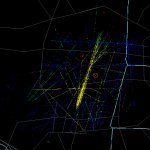I had been running an R820T Dongle into RTL1090 and sometimes trying Dump1090 for Windows using a homebrew Colinear 1090 MHz antenna. My results with both programs were pretty much identical, even though many state Dump1090 is better at decoding data. My range is limited in that I currently cannot put an antenna up outside, and am stuck using my homebrew on the second story of my townhouse.
Since I'm always trying to get better results, I purchased the new R820T2 Dongle and gave that a try. Results were slightly better than the R820T with the frame rates per second increasing a bit. I decided to try running both Dongles at the same time. The newer R820T2 would be connected to the homebrew antenna, and the R820T would be connected to a DPS Indoor Blade ADS-B antenna, and each Dongle would be connected to an instance of ADSB#. The two instances of ADSB# would be combined into one data stream using ModeSMixer2 and fed into Virtual Radar Server. The results were much improved over simply running either Dongle by itself.
Now if I could just figure out how to run multiple instances of RTL1090 or Dump 1090 to use that for comparison...
Since I'm always trying to get better results, I purchased the new R820T2 Dongle and gave that a try. Results were slightly better than the R820T with the frame rates per second increasing a bit. I decided to try running both Dongles at the same time. The newer R820T2 would be connected to the homebrew antenna, and the R820T would be connected to a DPS Indoor Blade ADS-B antenna, and each Dongle would be connected to an instance of ADSB#. The two instances of ADSB# would be combined into one data stream using ModeSMixer2 and fed into Virtual Radar Server. The results were much improved over simply running either Dongle by itself.
Now if I could just figure out how to run multiple instances of RTL1090 or Dump 1090 to use that for comparison...




